AI Outsourcing: How To Get It Right For Businesses In 2025?
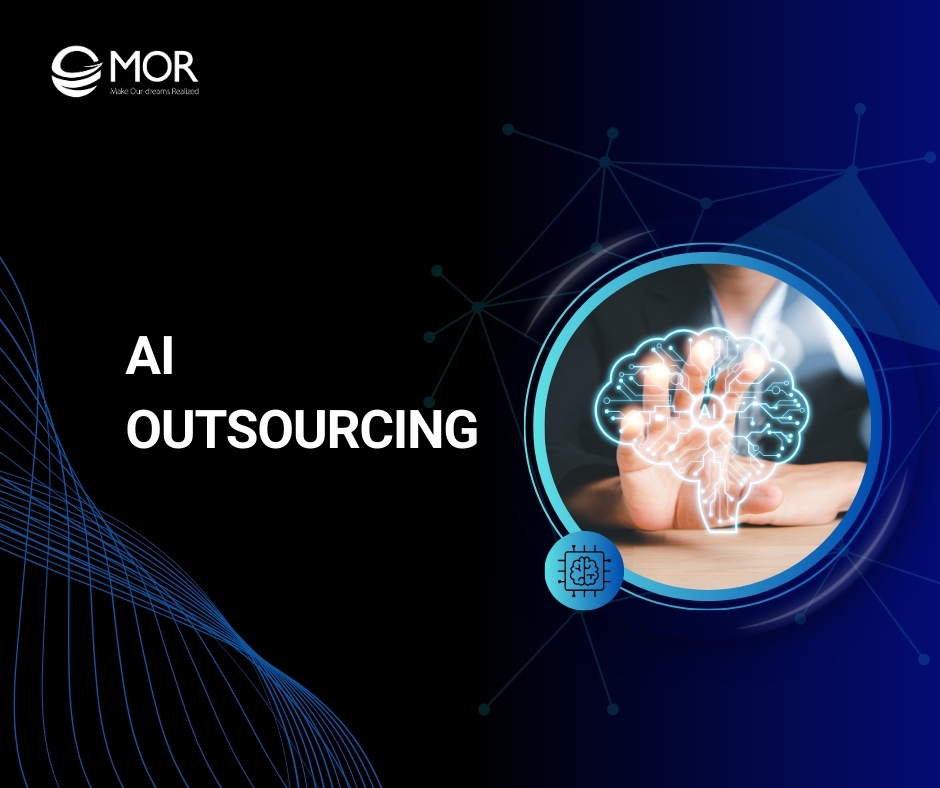
AI outsourcing helps businesses scale faster, cut costs, and tap into global talent without heavy in-house investment. This MOR Software’s guide shares proven strategies and tips to help you get it right in 2025.
What Is AI Outsourcing?
AI outsourcing is the practice of working with external specialists to plan, build, and maintain AI-driven solutions. This can include activities such as developing AI models, preparing and labeling datasets, running predictive analytics, or implementing AI automation tools.
Instead of investing heavily in recruiting and training an in-house AI team, businesses collaborate with AI outsourcing companies that already have the expertise, infrastructure, and tools to deliver results quickly and at a lower cost.
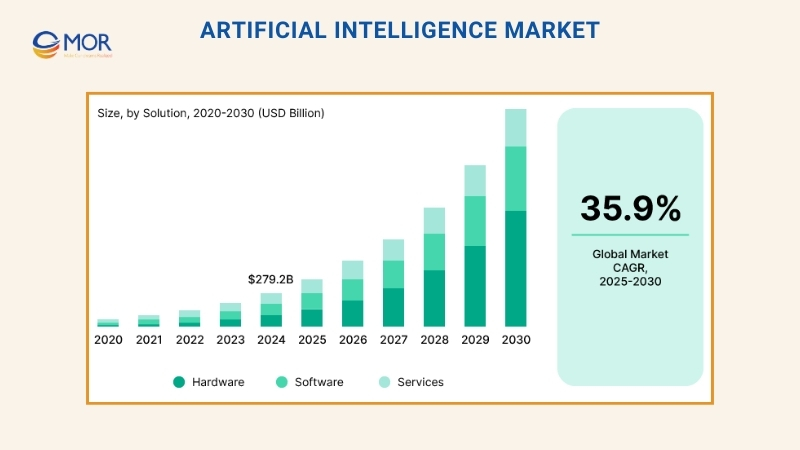
The market for AI outsourcing is expanding rapidly. In 2024, the global AI sector reached a value of $279.2 billion and is forecast to grow at a 35.9% CAGR between 2025 and 2030. A large portion of this growth will come from AI services, reflecting rising demand for outsourced expertise.
This approach allows organizations to access top-tier skills and proven processes without the long timelines and expenses of building internal capabilities from scratch.
Key Benefits Of Ai Outsourcing For Businesses
AI outsourcing can deliver measurable value across multiple areas of a business. From lowering costs to unlocking specialized expertise, its benefits extend well beyond technical gains.
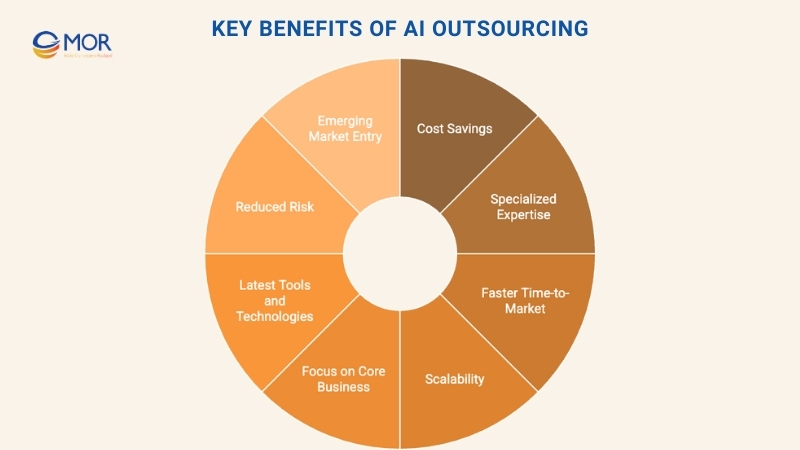
Cost Savings
Building an in-house AI team with roles like machine learning engineers, data scientists, and machine learning specialists can be extremely costly, particularly for startups and mid-sized businesses.
Current salary trackers show U.S. base pay ranges around $136k for AI Engineers and about $172k for ML Engineers, depending on title and market. When you add adjacent roles like Data Scientist and Data Engineer, a four-role core team’s base payroll is roughly $590k a year before bonuses and equity.
When factoring in the salaries of a complete AI team, yearly payroll can quickly surpass $500,000. Beyond staffing, companies must also invest heavily in infrastructure, software licenses, training, and ongoing research.
By turning to AI outsourcing services, organizations pay only for the scope of work they require, whether that’s a single AI model project or an ongoing development partnership. This flexible, on-demand approach helps reduce both capital expenses and day-to-day operational costs, freeing budgets for other strategic priorities.
Access To Specialized Expertise
Artificial intelligence covers a wide range of technologies, tools, and methods, each suited to specific business needs. Developing an AI-powered product for retail may require different frameworks and algorithms than one built for healthcare, finance, or manufacturing.
Partnering with AI outsourcing companies gives businesses direct access to seasoned experts who have successfully delivered AI solutions across multiple industries, bringing both technical know-how and practical implementation experience.
In recent years, Asia has emerged as a strong hub for AI talent, with countries like Vietnam, India, and China producing highly skilled engineers and data scientists trained in machine learning, data analytics, and automation.
These professionals not only bring specialized skills but also work at competitive rates, allowing companies to access world-class expertise at a significantly lower cost than building an in-house team.
Skills remain a top blocker for many enterprises, 33% cite limited AI skills and expertise as a primary barrier to adoption, which is why outside specialists are often engaged.
Faster Time-To-Market
In competitive markets, speed can be the difference between leading and lagging behind. AI outsourcing allows companies to bypass lengthy hiring processes, onboarding, and internal training, accelerating project kickoff by weeks or even months.
Instead of spending valuable time building an AI team from scratch, businesses can tap into external experts who are ready to start immediately.
An experienced outsourcing partner typically comes equipped with established development pipelines, pre-trained models, and proven workflows. This enables rapid deployment of AI solutions.
For example, an AI in financial services provider could work with an outsourcing team to deliver a fully functional fraud detection system in as little as three months, compared to the six to twelve months often needed for in-house development.
The three-month build has real precedent, an AWS case study describes a fraud prevention system completed in that timeframe. For in-house efforts, multiple industry guides place typical builds in the 3 to 6 or 6 to 12 month range depending on complexity.
Speed gains also come from skipping recruiting cycles, data scientist roles alone often take 60 to 70 days to fill, before onboarding.
Scalability
AI projects often begin as small experiments but can quickly expand once their benefits are proven. AI outsourcing services make it easier for companies to scale resources up or down in line with changing project needs.
Whether transitioning from a proof-of-concept to a fully deployed solution or extending AI adoption across multiple business units, an outsourcing partner can adjust team capacity, skill sets, and technologies to match the new scope without disrupting timelines.
Focus On Core Business
Running AI development entirely in-house can pull attention and resources away from essential operations like sales, marketing, or customer support. By partnering with specialists, businesses can leave the AI development process in capable hands while keeping internal teams focused on strategic goals.
For instance, a logistics company might prioritize improving delivery efficiency and client relationships, while an outsourced team builds and refines the algorithms that optimize delivery routes, ensuring both smoother workflows and better resource utilization.
Access To The Latest Tools And Technologies
The AI field moves fast, with new frameworks, libraries, and embeded software development tools appearing almost every month.
Partnering with AI outsourcing companies gives businesses access to teams that actively track and adopt these advancements. They work with modern, well-supported technologies to ensure solutions are efficient, maintainable, and adaptable.
This proactive approach reduces the chance of technical debt and provides a stable, future-ready platform that can grow with your business needs.
Analysts expect more than 80% of enterprises to be using generative AI APIs or deploying GenAI apps by 2026, up from less than 5% in 2023, which raises the bar on toolchains and integration know-how.
Reduced Risk
Every AI initiative comes with uncertainties, from underperforming models to incomplete datasets or shifting market conditions. AI outsourcing offers a safer way to explore these projects by allowing companies to test, validate, and refine ideas without committing to long-term internal investments.
This flexibility encourages a rapid experimentation culture, enabling businesses to fail fast, learn quickly, and move forward with proven solutions while minimizing exposure to unnecessary risks.
Easier Entry Into Emerging Markets Or Domains
Breaking into a new industry or market that relies on AI, such as entering logistics with route optimization technology, often involves steep learning curves and significant investment in specialized knowledge.
AI outsourcing offers a practical, low-barrier approach to explore and launch AI-driven products or services without first building deep in-house expertise. By working with an experienced partner, businesses can validate concepts, adapt to market demands, and roll out solutions faster, reducing both the time and cost associated with entering unfamiliar territories.
6 Proven AI Outsourcing Approaches To Consider
Businesses can choose from several AI outsourcing models, each suited to different goals, budgets, and internal capabilities. Understanding these approaches will help you select the one that delivers the best results for your needs.
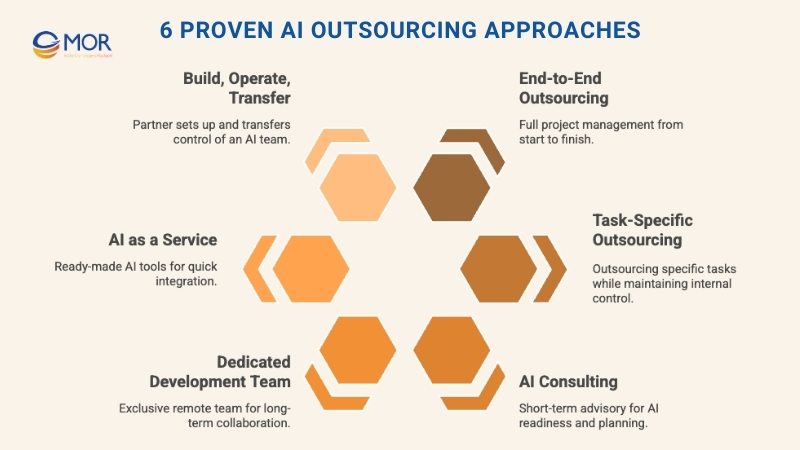
End-To-End AI Outsourcing
With this model, the outsourcing partner manages the entire AI development lifecycle, covering everything from requirement analysis to deployment and ongoing support.
It is well-suited for organizations with little to no internal AI capability or those wanting a complete, ready-to-use solution without getting involved in complex technical processes.
For instance, a startup planning to launch an AI-powered customer service chatbot could work with an AI based customer support service company and outsourcing provider that oversees every stage, including design, coding, testing, and final deployment.
Task-Specific AI Outsourcing
Here, businesses delegate certain segments of an AI initiative, such as dataset labeling, algorithm testing, or front-end integration, while retaining control over the main development work internally.
This approach lets organizations benefit from specialized skills for targeted tasks without giving up authority over the overall project direction, making it a balanced option for teams that already have some AI capabilities in place.
AI Consulting
AI outsourcing services can also take the form of short-term, strategy-focused consulting engagements. In these cases, consultants evaluate a company’s readiness for AI adoption, identify suitable business cases, and outline high-level architectures or implementation roadmaps.
This option is particularly useful for organizations at the early stages of their AI journey, helping them build a clear plan before committing significant resources to development.
Dedicated Development Team
This model involves partnering with a remote, full-time AI development team that works exclusively on your projects. It combines the control of an in-house team with the flexibility of outsourcing, enabling consistent collaboration and knowledge sharing over extended periods.
Businesses gain ongoing access to specialized talent without the costs and commitments of permanent hires, making it an effective approach for scaling AI capabilities strategically.
AI As A Service (AIaaS)
In the AI outsourcing landscape, AI as a Service refers to vendors delivering ready-made, cloud-hosted AI solutions that can be integrated into business workflows with minimal configuration.
Common examples include customer service chatbots, product recommendation engines, or fraud detection systems that are already trained and optimized for quick adoption.
For example, an e-commerce retailer could use an AI outsourcing companies platform offering a pre-built recommendation engine to instantly personalize product suggestions, achieving faster rollout and improved customer engagement without lengthy development cycles.
Market momentum supports this route, IDC expects worldwide AI spending to reach about $632 billion in 2028. This shows strong demand for software, services, and cloud platforms..
Build, Operate, Transfer (BOT)
With the BOT model, the outsourcing partner establishes and manages a dedicated AI development team on behalf of the client.
Once the team is fully operational and processes are running smoothly, control is transferred back to the client’s organization. This approach works well for companies aiming to eventually own and manage their AI capabilities in-house while benefiting from expert setup and operational support during the early stages.
Comparison Of AI Outsourcing Approaches
Approach | Pros | Cons | Best For |
| End-To-End Outsourcing | Minimal client involvement, rapid delivery, full accountability from vendor | Reduced control, limited internal knowledge gain | Non-technical businesses, startups, SMEs |
| Task-Specific Outsourcing | Flexible, cost-conscious, taps into external expertise for targeted needs | Requires strong internal project management, potential integration challenges | Companies with existing AI or project teams |
| AI Consulting | Provides strategic direction, lowers risks, delivers quick assessments | Not an execution-focused model, may require additional vendors for delivery | Organizations starting AI exploration |
| Dedicated Development Team | Long-term collaboration, greater oversight, scalable team structure | Higher expense than task outsourcing, requires consistent coordination | Enterprises creating core AI products or pursuing R&D |
| AI as a Service (AIaaS) | Fast implementation, budget-friendly, no need to hire internally | Limited customization, may not fit highly complex requirements | E-commerce, outsource AI customer services, marketing analytics |
| Build, Operate, Transfer (BOT) | Enables knowledge transfer, grants eventual ownership, vendor sets up team | Longer time to full operation, higher upfront investment | Large enterprises building AI hubs or in-house teams |
Key Use Cases for AI Outsourcing Across Industries
AI’s capacity to learn, adapt, and replicate aspects of human reasoning makes it valuable in nearly every sector. Organizations use it to improve operational efficiency, scale processes, and deliver better customer experiences. Below are notable examples of how AI outsourcing is applied across industries.
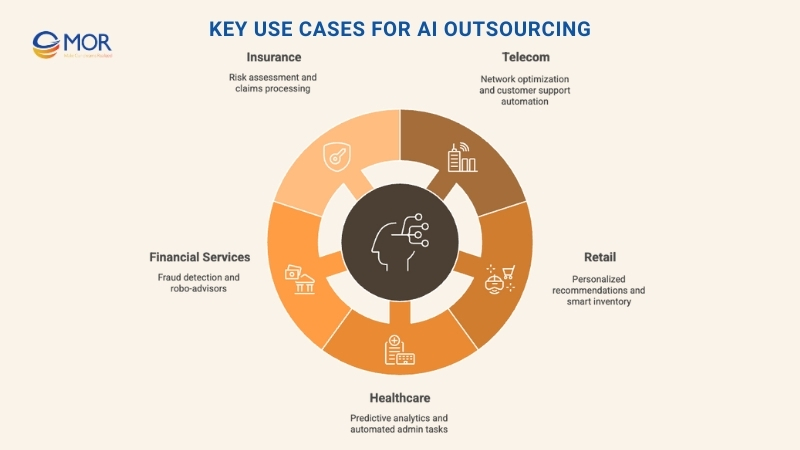
Telecom
The telecom sector thrives on reliable connectivity and high-quality customer support, making it a strong candidate for AI adoption. By 2023, 41% of telecom companies had already implemented AI, and another 48% were exploring it.
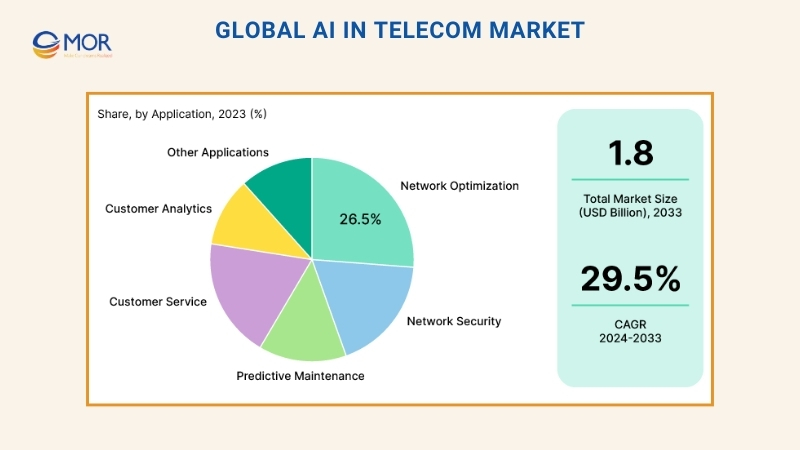
Lacking internal AI expertise, many providers work with AI outsourcing companies to design and deploy solutions such as:
- Network optimization using real-time monitoring and predictive analytics
- AI-powered chatbots to improve responsiveness and customer satisfaction
- Fraud detection systems leveraging advanced machine learning models
- Automated billing, account management, and service requests through robotic process automation (RPA)
Retail
Retail success depends on understanding customer behavior and consistently delivering a great shopping experience. By partnering with AI outsourcing services, retailers can implement advanced solutions that boost sales, strengthen customer loyalty, and improve operational efficiency. Common applications include:
- AI-driven chatbots and virtual assistants powered by natural language processing (NLP) to deliver round-the-clock customer support
- Personalization systems that recommend products and promotions tailored to each shopper’s preferences
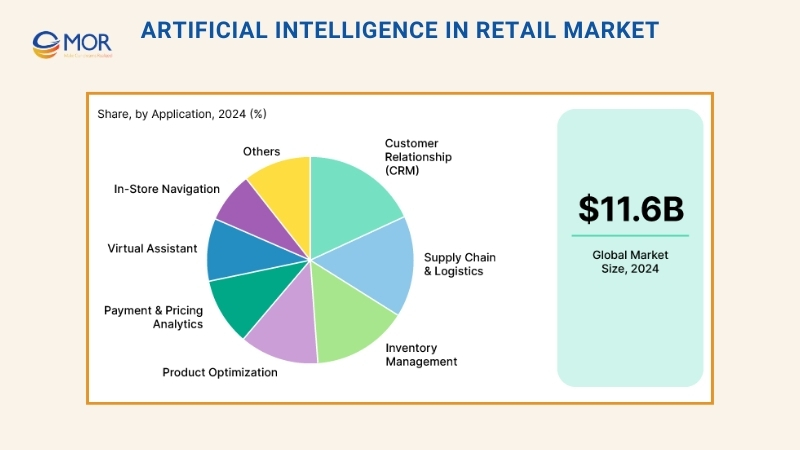
- Smart inventory and supply chain management tools that minimize overstock, prevent shortages, and align supply with real demand
- Dynamic pricing engines that adjust offers in real time based on buyer data and stock availability
- Automated marketing workflows that produce targeted, AI-generated content to engage customers at scale
Healthcare
Healthcare organizations must deliver precise, timely care while keeping operations efficient. By collaborating with AI outsourcing companies, hospitals and clinics can adopt advanced technologies without investing heavily in in-house development. Notable applications include:
- Smart hospital systems integrating AI with IoT devices to improve operational performance
- AI-assisted triage tools that prioritize urgent cases and shorten patient wait times
- Predictive analytics tools that help forecast potential health risks
- Automated administrative workflows, from scheduling appointments to processing billing tasks
Financial Services
In financial services, artificial intelligence transforms complex datasets into valuable business insights. Partnering with AI outsourcing services enables firms to deploy these innovations faster and more effectively. Key use cases include:
- Real-time fraud detection and anomaly identification across transactions
- AI-driven credit risk evaluation using detailed customer profiles
- Robo-advisors and portfolio analytics tools powered by machine learning
- AI-enabled chatbots to handle customer inquiries and streamline onboarding processes
Insurance
The insurance sector operates on tight profit margins, making precision in risk assessment essential. Collaborating with AI outsourcing companies allows insurers to deploy advanced tools that improve both accuracy and customer satisfaction. Common use cases include:
- Predictive models that assess customer risk profiles, accelerating the policy underwriting process
- Automated claims management systems that cut processing times and improve efficiency
- Fraud detection algorithms that identify suspicious activity before it causes financial loss
- AI-powered engines that generate personalized policy quotes and tailored coverage recommendations
Common Challenges In AI Outsourcing Projects
While AI outsourcing delivers significant benefits, organizations should also recognize the challenges that can influence a project’s success. Identifying these early makes it easier to plan mitigation steps and select the most suitable outsourcing approach.
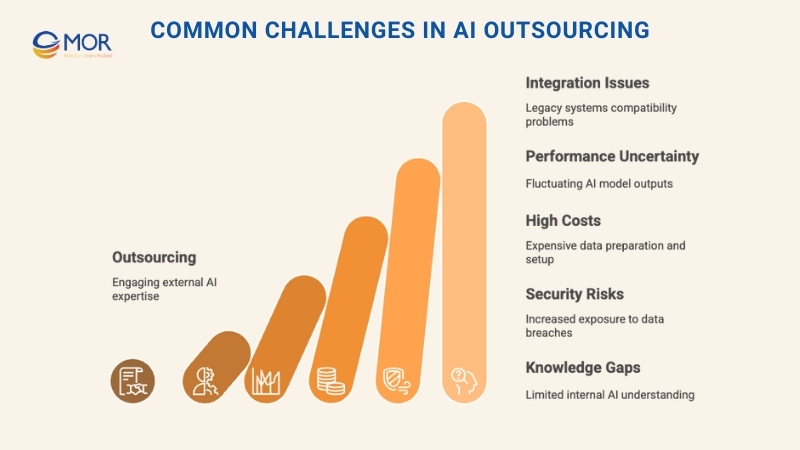
Integrating With Legacy Systems
A frequent obstacle is connecting new AI solutions with existing legacy infrastructure or proprietary platforms. If an outsourced system is developed without proper coordination with the internal IT environment, integration can become complicated and prone to errors.
To avoid this, it’s essential to maintain thorough documentation and foster close collaboration between the vendor and in-house teams, ensuring a smooth and reliable rollout.
Uncertainty In AI Model Performance
AI models, particularly those built with machine learning or deep learning techniques, are inherently probabilistic. Even with quality datasets and robust development, outputs can fluctuate or shift over time.
This variability may affect user trust and decision-making confidence. Partnering with AI outsourcing services providers who prioritize explainable AI, implement ongoing performance monitoring, and retrain models using feedback loops can help maintain accuracy and reliability over the long term.
High Initial Implementation Costs
Although AI outsourcing is often more cost-effective than building an in-house team, AI projects can still require substantial investment, particularly during early phases involving data preparation, infrastructure setup, and model training.
Unexpected changes in project scope or the use of overly complex models can drive costs higher. To keep budgets under control, it’s essential to define project requirements clearly and maintain open, transparent communication with outsourcing partners.
Data Security And Privacy Risks
AI solutions depend heavily on data, which often includes sensitive or proprietary information. Collaborating with external providers introduces risks such as data breaches or intellectual property leaks.
To reduce these risks, businesses should thoroughly assess partners’ data protection practices, require non-disclosure agreements (NDAs), verify secure infrastructure, and ensure vendors hold relevant compliance certifications.
Gaps In Internal AI Understanding
Even with development handled by an external provider, a lack of internal AI literacy can slow adoption and limit success. If leadership or operations teams cannot interpret AI outputs or understand system logic, decision-making may suffer.
Partnering with AI outsourcing companies that also provide internal training, detailed documentation, and ongoing support helps bridge this gap and ensures effective knowledge transfer.
How To Select The Right AI Outsourcing Partner?
Choosing the right AI outsourcing partner can elevate your business capabilities, while the wrong one can result in wasted investment and lost opportunities. The following steps will help you navigate the selection process with confidence.
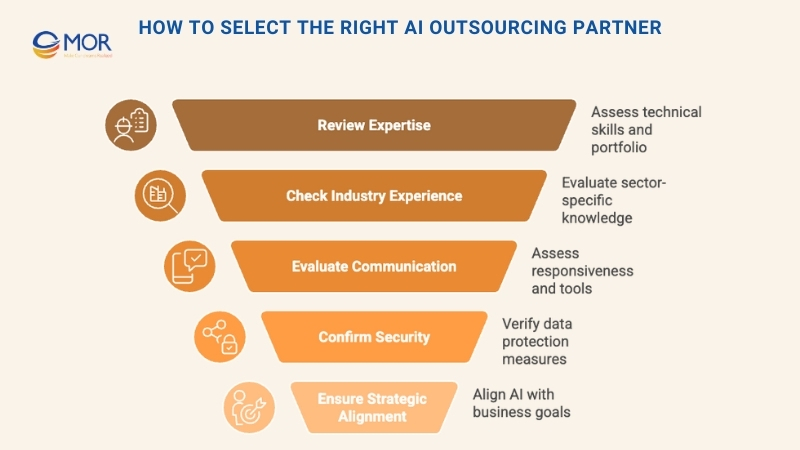
Define Your AI Goals And Requirements
Before approaching any vendor, clearly assess your AI maturity, business objectives, and the results you want to achieve.
Key steps:
- Set clear objectives: Determine if you need a complete product, a proof-of-concept, or strategic guidance.
- Specify requirements: Identify if your needs involve industry-specific solutions such as predictive maintenance, fraud detection, or personalized recommendations.
- Align expectations: Clarifying your vision will make it easier to select partners whose capabilities match your goals, timeline, and budget.
Review Portfolio And Technical Expertise
Assess the vendor’s track record in delivering AI development services to understand their technical skill set and problem-solving ability. A qualified partner should demonstrate both knowledge of leading AI tools (like TensorFlow and PyTorch) and the ability to apply them in real-world business contexts.
Key actions:
- Examine case studies: Request detailed examples to evaluate their approach and measurable outcomes.
- Contact client references: Speak directly with past customers to learn about their working relationship and satisfaction levels.
- Request technical demos: Ask for access to code repositories or demo environments to validate their capabilities.
Look For Industry-Specific Experience
AI requirements can differ widely between sectors, so selecting an AI outsourcing partner with proven experience in your industry is essential. A vendor familiar with your field will better understand unique operational challenges, compliance standards, and customer expectations, enabling them to deliver more tailored and effective solutions.
You should check for:
- Well-defined project plans with clear milestones and deliverables.
- Commitment to regular updates and progress reports to keep all parties aligned.
- A single point of contact, such as a dedicated project or account manager, to streamline communication.
- Flexible engagement models, hourly, fixed-price, or dedicated teams, matched to your budget and scope.
Evaluate Communication And Collaboration Practices
Strong communication is a cornerstone of successful outsourcing relationships. Assess how responsive the vendor is, their preferred communication channels, and their ability to grasp and articulate your project goals. Time zone compatibility, meeting availability, and cultural fit should also be considered.
Key considerations:
- Communication and project management tools: Determine if they use platforms like Slack, Zoom, SharePoint, or Asana for efficient coordination.
- Language skills: Ensure the team can communicate fluently in your preferred language to reduce the risk of misunderstandings and delays.
Confirm Security And Compliance Measures
Since AI outsourcing projects often work with sensitive or proprietary information, strong data protection practices are non-negotiable. Your vendor should follow strict security protocols and comply with all applicable regulations.
Key questions to ask:
- Encryption methods: How is data protected both in transit and at rest?
- Access controls: What systems are in place to ensure only authorized personnel can view or handle data?
- Audit logs: Do they track all data access and changes for accountability?
- Data storage policies: Where is the data hosted, and what safeguards are used to protect it from breaches?
Ensure Strategic Alignment
An effective AI outsourcing services partner should not only deliver models but also align their work with your broader business objectives. They need to help identify the right problems to solve and ensure solutions create measurable value.
Consider the following:
- Workflow improvements: Does the partner recommend how AI can enhance your current operations?
- Roadmap collaboration: Are they open to co-developing an AI roadmap that supports your long-term goals?
- Industry awareness: Do they proactively share updates on emerging technologies and trends relevant to your sector, keeping you ahead of competitors?
MOR Software As Your AI Outsourcing Partner
MOR Software is a trusted software outsourcing company in Vietnam, known for delivering tailored custom AI solutions that help businesses scale faster, operate smarter, and stay competitive. We combine deep technical expertise with an agile, client-focused approach to turn AI ideas into high-performing solutions.
What sets us apart:
- End-to-end AI capabilities: From initial strategy consulting and proof-of-concept builds to full-scale AI system development, upgrades, and ongoing optimization, we cover the complete AI lifecycle.
- Industry-specific experience: We have delivered AI-powered solutions in sectors such as finance, healthcare, manufacturing, retail, and human resources, addressing unique challenges and compliance requirements in each.
- Broad technology expertise: Our teams work with leading AI and software frameworks, including TensorFlow, PyTorch, LangChain, OpenCV, Python, Java, and cloud platforms like AWS, Azure, and Google Cloud.
- Agile delivery model: We apply Agile and Scrum methodologies to deliver results in short, iterative cycles, ensuring flexibility and fast adaptation to changes.
- Security-first approach: We follow enterprise-grade data protection practices, from encryption and access control to compliance with global standards, keeping sensitive business information secure.
Whether you’re looking for a dedicated AI development team, specialized AI consulting, or an outsourcing partner to manage your full AI roadmap, MOR services brings the right mix of technical skill, industry knowledge, and commitment to help you succeed.
Conclusion
AI outsourcing offers businesses a smarter path to adopt and scale AI without the high costs, long timelines, or steep learning curves of building everything in-house. By choosing the right model, addressing potential challenges early, and partnering with experienced vendors, companies can unlock new opportunities, improve efficiency, and stay competitive. If you’re ready to explore tailored AI outsourcing services that align with your goals, contact MOR Software today.
MOR SOFTWARE
Frequently Asked Questions (FAQs)
What are the 4 types of AI?
The four types of AI are:
- Reactive Machines
- Limited Memory
- Theory of Mind
- Self-aware AI
What are the 4 types of AI?
The four main categories of AI are reactive machines, limited memory systems, theory of mind, and self-aware AI. Each type has distinct capabilities, from handling simple rule-based tasks to understanding human emotions and self-reflection.
Who is an outsourcing company?
An outsourcing company provides services on behalf of other businesses, ranging from IT, software development, and application management to customer support and digital marketing. Many companies choose outsourcing providers in countries like India due to a large pool of skilled talent and competitive pricing.
What is the difference between outsourcing and artificial intelligence?
Artificial intelligence refers to technologies like machine learning, natural language processing, and computer vision that enable systems to perform tasks that usually require human intelligence. Outsourcing, in contrast, is the practice of contracting specific business functions to third-party providers instead of managing them internally.
How will AI disrupt outsourced?
AI is transforming outsourcing by automating repetitive and rules-based tasks, enhancing productivity, and minimizing human errors. Business Process Outsourcing (BPO) providers increasingly integrate AI tools to speed up workflows, reduce costs, and deliver more consistent results.
What are the three different types of outsourcing?
The main outsourcing types are:
- Professional outsourcing – Ideal for businesses lacking specific expertise or skill sets.
- IT outsourcing – Helps companies expand technology capabilities without high internal costs.
- Process-specific outsourcing – Focused on outsourcing individual tasks or processes that require specialized handling.
How is AI used in sourcing?
AI supports procurement and sourcing by streamlining supplier research, improving vendor management, and automating parts of the purchasing process. It also helps organizations forecast supply chain changes and identify cost-saving opportunities with greater accuracy.
What is the difference between outsourcing and BOT?
In traditional outsourcing, the service provider runs operations while the client oversees performance through agreements and KPIs. In a Build-Operate-Transfer (BOT) model, the provider sets up and manages the operation initially, then fully hands over control and ownership to the client once it’s established.
What is technology outsourcing?
Technology outsourcing, or ICT outsourcing, is when a business contracts out IT and tech-related services to a specialized provider. This approach reduces operational costs, fosters innovation, and allows t
Rate this article
0
over 5.0 based on 0 reviews
Your rating on this news:
Name
*Email
*Write your comment
*Send your comment
1